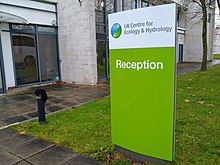UK Centre for Ecology & Hydrology
UK environmental science research organisation From Wikipedia, the free encyclopedia
UK environmental science research organisation From Wikipedia, the free encyclopedia
The UK Centre for Ecology & Hydrology (UKCEH) is a centre for excellence in environmental science across water, land and air. The organisation has a long history of investigating, monitoring and modelling environmental change. It operates from four sites in the UK and one in Ghana. Research topics include: air pollution, biodiversity, chemical risks in the environment, extreme weather events, droughts, floods, greenhouse gas emissions, soil health, sustainable agriculture, sustainable ecosystems, water quality, and water resources management.
 | |
 | |
| Abbreviation | UKCEH |
|---|---|
| Formation | 1994[1] |
| Legal status | Not-for-profit company limited by guarantee with charitable status |
| Purpose | Environmental science for a world where people and nature prosper |
| Headquarters | Wallingford, Oxfordshire, U.K. |
| Location |
|
Region served | International |
Chief Executive | Stuart Wainwright |
| Website | www |
UKCEH coordinates a number of long-term environmental science monitoring sites and programmes, including the Predatory Bird Monitoring Scheme, the Isle of May Long-Term Study, the UK National River Flow Archive, the Plynlimon catchment study, lakes monitoring at Loch Leven and in the English Lake District, the UK Cosmic-ray soil moisture monitoring network (COSMOS-UK), the UK Upland Waters Monitoring Network, the Biological Records Centre, and the UKCEH Countryside Survey.[2] The centre manages an urban atmospheric pollution observatory at the top of BT Tower in London. Its international work includes collaboration with the World Meteorological Organization on a global hydrological monitoring initiative [3] and working with European partners to set up butterfly and wider pollinator monitoring schemes.[4]
UKCEH is a strategic delivery partner for the Natural Environment Research Council (NERC), part of UK Research and Innovation (UKRI). The institute has four locations: Wallingford (its headquarters), Edinburgh, Lancaster and Bangor.
UKCEH is a member of the Partnership for European Environmental Research (PEER).[5]
The Centre for Ecology & Hydrology (CEH) was formally established in March 1994 by John Krebs the then Chief Executive of NERC. It was formed by the drawing together of four research institutes: the Institute of Hydrology, the Institute of Terrestrial Ecology,[6] the Institute of Freshwater Ecology and the Institute of Virology and Environmental Microbiology (IVEM).[1]
In 1994, Brian Wilkinson a Professor of Civil Engineering at Cranfield University, Director of the Institute of Hydrology, was appointed as the first CEH Director. In 1994 CEH had 15 laboratories and field stations across the UK. From 1996 onwards the number of sites was reduced and the centre now[when?] operates from 4 locations across the UK.
In the early years there was a need to integrate environmental science across the institutes: joint science programs were established together with an inter-disciplinary science fund. CEH expanded and by 1999 there were some 600 staff and about 300 students linked to the universities, with most registered for post-graduate qualification. CEH had global outreach with around 60 worldwide research projects.[1] A new headquarters was constructed on the Wallingford site.
In 1999 Wilkinson retired and Mike Roberts was appointed as CEH Director. He was succeeded by Professor Nuttall in 2001. In 2012 Mark Bailey was appointed to the position of Executive Director.
In December 2019, following UK Government approval, the Centre for Ecology & Hydrology became autonomous from UK Research and Innovation (UKRI) and the Natural Environment Research Council (NERC), launching as a not-for-profit company limited by guarantee with charitable status on 1 December that year. At the same time, it also changed its name to the UK Centre for Ecology & Hydrology (UKCEH).
Dr Stuart Wainwright OBE became Chief Executive in June 2023.[7]
Seamless Wikipedia browsing. On steroids.
Every time you click a link to Wikipedia, Wiktionary or Wikiquote in your browser's search results, it will show the modern Wikiwand interface.
Wikiwand extension is a five stars, simple, with minimum permission required to keep your browsing private, safe and transparent.